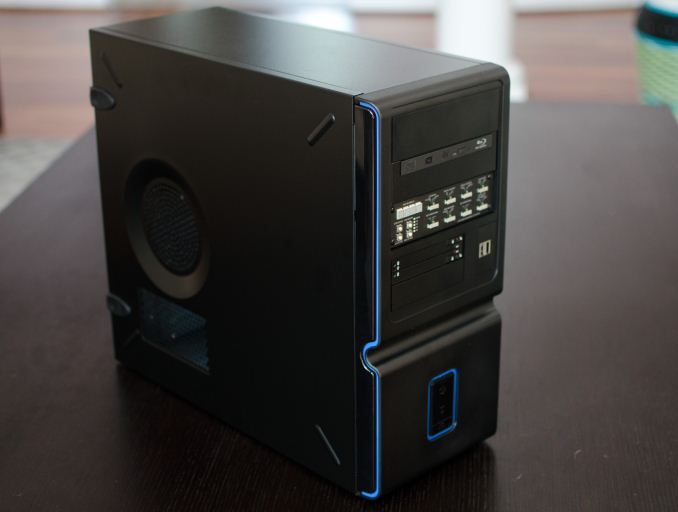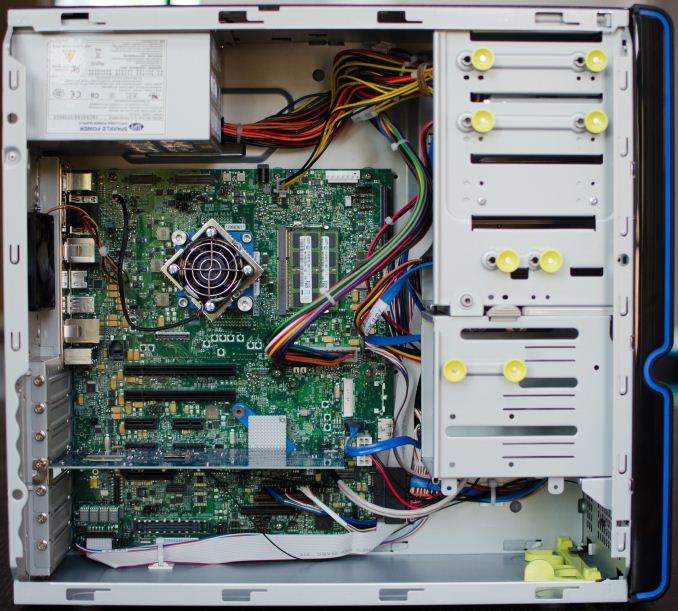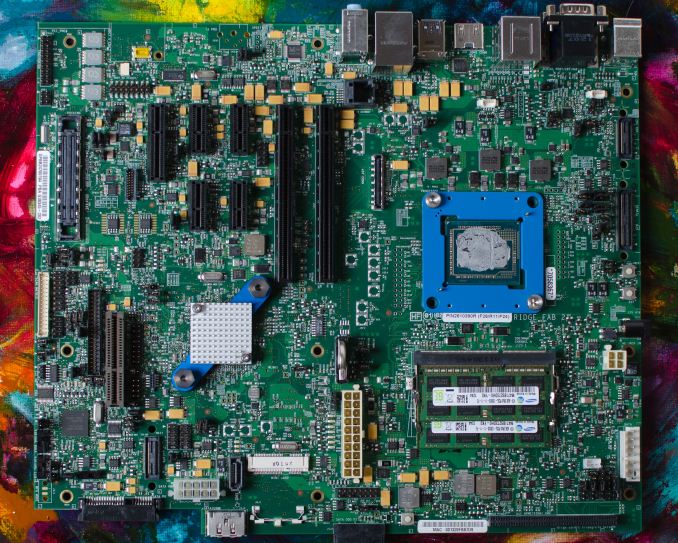Intel Iris Pro 5200 Graphics Review: Core i7-4950HQ Tested
by Anand Lal Shimpi on June 1, 2013 10:01 AM ESTThe Core i7-4950HQ Mobile CRB
At a high level, Iris Pro 5200 would seem to solve both problems that plagued Intel graphics in the past: a lack of GPU hardware and a lack of memory bandwidth. As a mostly mobile-focused design, and one whose launch partner isn’t keen on giving out early samples, it seemed almost impossible to evaluate Iris Pro in time for the Haswell launch. That was until a week ago when this showed up:
What may look like a funny mid-tower from a few years ago is actually home to one of Intel’s mobile Customer Reference Boards (CRB). Although the chassis is desktop-sized, everything inside is optimized for mobile. It’s just easier to build things larger, especially when it comes to testing and diagnosing problems.
The silicon on-board is a 47W Core i7-4950HQ, the lowest end launch SKU with Iris Pro 5200 graphics. The chassis is obviously overkill for a 47W part, but the performance we get with this machine should be representative of any i7-4950HQ system with a cooler capable of dissipating 47W.
If you read our Haswell CPU review you’ll know that Intel tried to be stingy with telling us die sizes and transistor counts for the bulk of the Haswell lineup, electing to only give us data on dual-core Haswell GT3 and quad-core Haswell GT2. Knowing that mobile parts ship without integrated heat spreaders, I went to work on pulling off the i7-4950HQ’s heatsink (after I finished testing, just in case).
With the heatsink off and thermal paste wiped off, I used my bargain basement calipers to get a rough idea of die area. This is what I came up with:
| Intel Haswell | |||||||||||||||||
| CPU Configuration | GPU Configuration | Die Size | Transistor Count | ||||||||||||||
| Haswell GT3e (QC) | Quad-Core | GT3e | 264mm2 + 84mm2 | ? | |||||||||||||
| Haswell GT2 (QC) | Quad-Core | GT2 | 177mm2 | 1.4B | |||||||||||||
| Haswell ULT GT3 | Dual-Core | GT3 | 181mm2 | 1.3B | |||||||||||||
The Crystalwell die measures 7mm x 12mm (84mm^2), while the quad-core Haswell + GT3 die is a whopping 264mm^2 (16.2mm x 16.3mm). Working backwards from the official data Intel provided (177mm^2 for quad-core GT2), I came up with an 87mm^2 adder for the extra hardware in Haswell GT3 vs. GT2. Doubling that 87mm^2 we get a rough idea of how big the full 40 EU Haswell GPU might be: 174mm^2. If my math is right, this means that in a quad-core Haswell GT3 die, around 65% of the die area is GPU. This is contrary to the ~33% in a quad-core Haswell GT2. I suspect a dual-core + GT3 design is at least half GPU.














177 Comments
View All Comments
tipoo - Saturday, June 1, 2013 - link
I really hope so, the Retina Macbook Pro 13" would get a whole lot more appealing with quad core and Iris Pro.DanNeely - Saturday, June 1, 2013 - link
Probably; easily if anand is right about Apple deciding it's good enough to drop the dGPU. Worst case would be Apple taking advantage of the adjustable TDP options to tune the CPU performance/tdp down a bit.Gaugamela - Saturday, June 1, 2013 - link
Really impressive!This focus of Intel on graphics will force Nvidia and AMD to push dedicated GPUs forward at a much faster pace at the risk of being destroyed by Intel iGPUs. This couldn't come at a better time with the advent of high resolution screens in notebooks and displays (that new 4K Asus monitor).
AMD will need to bring Kaveri with a monster of a iGPU otherwise Intel just nullified the only area where they had any type of advantage.
Blibbax - Saturday, June 1, 2013 - link
I question how much more can be had from APU graphics with the bandwidth restrictions of 64-bit DDR3.silverblue - Saturday, June 1, 2013 - link
Iris Pro is exceptionally good, however you have to ask how much faster the 7660D would be with the same memory bandwidth advantage. Additionally, Trinity is hardly going to be in the same sort of systems, and as the GPU is being held back by the CPU part anyway, it does take a little shine off Iris Pro's astounding performance. Even so, well done Intel, on both the hardware and software fronts.trulyuncouth1 - Saturday, June 1, 2013 - link
I think its kind of a moot point, Selling something this expensive will not affect AMD or even Nvidia that much. You can get an entire AMD APU based notebook for the cost of just this processor. I love the idea of this being pushed forward but unless Intel can bring it to a lower price point its kind of pointless.ilkhan - Saturday, June 1, 2013 - link
Im probably unique in that I want a quad haswell with the 20EU graphics and a GTX760m dGPU from a latitude (dock!) E6540. Wonder if thats going to happen. Probably not.Still, this looks damn good for Intel and will only improve over time.
lmcd - Sunday, June 2, 2013 - link
Howabout, rather, a 760 dGPU from a latitude dock? A bit more appealing :-)Zandros - Saturday, June 1, 2013 - link
Performance roughly in line with expectations, although the compute performance is a nice surprise. It seems to me like Crystalwell is going into exactly the wrong SKUs and the pricing is borderline atrocious, too.Anyway, since you bring up the awards and a "new system" for them, something I've been thinking a bit about is how there doesn't seem to be a page on the site where it is explained what each award is supposed to mean and collects all the products that have received them, which I think would be nice.
kallogan - Saturday, June 1, 2013 - link
Where is da power consumption ??????